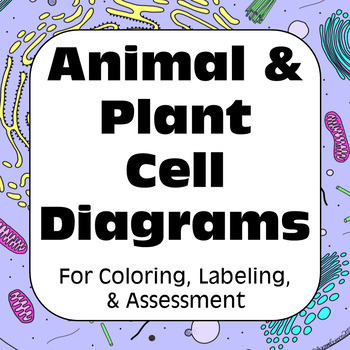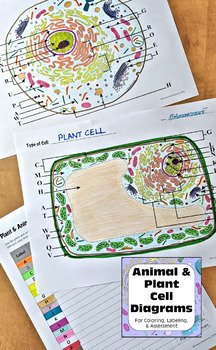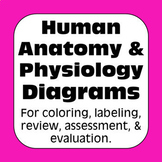Plant & Animal Cell Diagrams for Coloring Matching Labeling Quizzes & Reference
- PDF
- Easel Activity
Also included in
- Anatomy and physiology, human body system diagrams perfect for coloring, labeling, review, assessment, and evaluation.Includes the brain, the heart and cardiovascular system, digestive system, respiratory system, urinary system, animal cell and plant cell.Please see individual files included in thisPrice $16.20Original Price $18.00Save $1.80
- Please see individual files included in this bundle for additional details.Click here to follow my store and receive the latest updates.Original Artwork (©AwesomeScience). For Personal Use Only. Uneditable.Page count does not include Terms of Use and links to supplementary activities. Copyright ©AwePrice $80.89Original Price $89.88Save $8.99
- A bundle of activities for plant biology - botany - students.Please see individual files for additional details.Click here to follow my store and receive the latest updates.Original Artwork (©AwesomeScience). For Personal Use Only. Uneditable.Page count does not include Terms of Use and links to supPrice $6.15Original Price $6.83Save $0.68
Description
Plant cell and animal cell diagrams for practice and/or assessment. Perfect for middle school or high school biology. Pages may be used for coloring, labeling, etc. or, laminated and used as a reference for assessment/evaluation. Original hand-drawn artwork @AwesomeScience.
Includes:
- 1 plant cell and 1 animal cell, unlabeled;
- 1 plant cell and 1 animal cell labeled A-W with student answer page for matching purposes;
- 1 plant cell and 1 animal cell labeled 1-23 with lines for student answers;
- 1 plant cell and 1 animal cell labeled with optical mark recognition (OMR) codes (A, B, C, D, E, AB, AC, etc.). Use this diagram as a reference page within your quiz/unit test and add your own questions. Students choose the correct answer and record the correct letter combination on their OMR record sheet.
- 5 answer pages.
Cell parts identified in these original artwork diagrams:
Cell membrane / Plasma membrane
Cell wall
Centrioles
Chloroplasts
Chromatin
Cytoplasm
Cytoskeleton
DNA
Golgi body / Golgi apparatus / Golgi complex
Intermediate filaments
Lysosomes
Microfilaments
Microtubules
Mitochondria
Nuclear membrane
Nuclear membrane pore
Nucleolus
Peroxisomes
Ribosomes
Rough endoplasmic reticulum
Smooth endoplasmic reticulum
Vacuoles
Vesicles
Click here to follow my store and receive the latest updates.
Original Artwork (©AwesomeScience). For Personal Use Only. Uneditable.
Page count does not include Terms of Use and links to supplementary activities.
Copyright ©AwesomeScience 2018 – The Present.
All Rights Reserved by Author.
By using this Resource you agree to the Terms as outlined in the Terms of Service. This Resource is for limited Personal Use only; not to be used, in part or in whole, for commercial purposes. Each Individual License is for use by one specific educator only. Additional licenses must be purchased for each additional educator. Except as permitted in Section 3 to deliver Resources electronically to Permitted Recipients, you may not post or otherwise make the Resource available on any website, application, shared drive or other sites or services.








